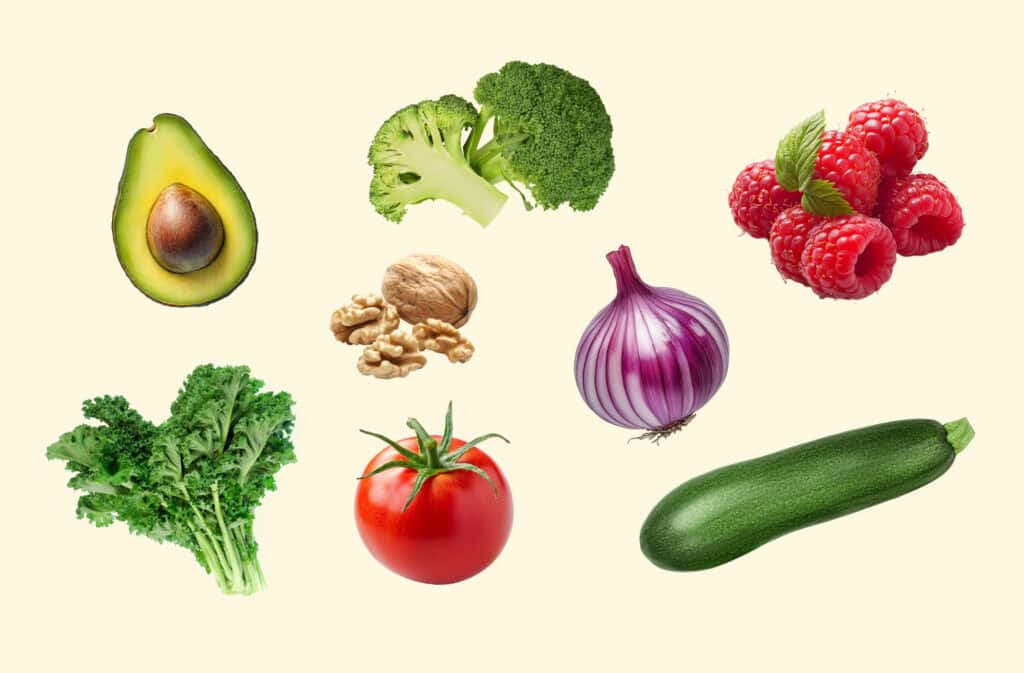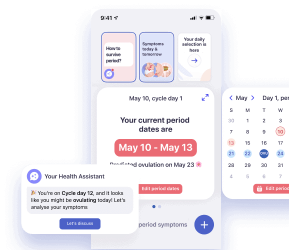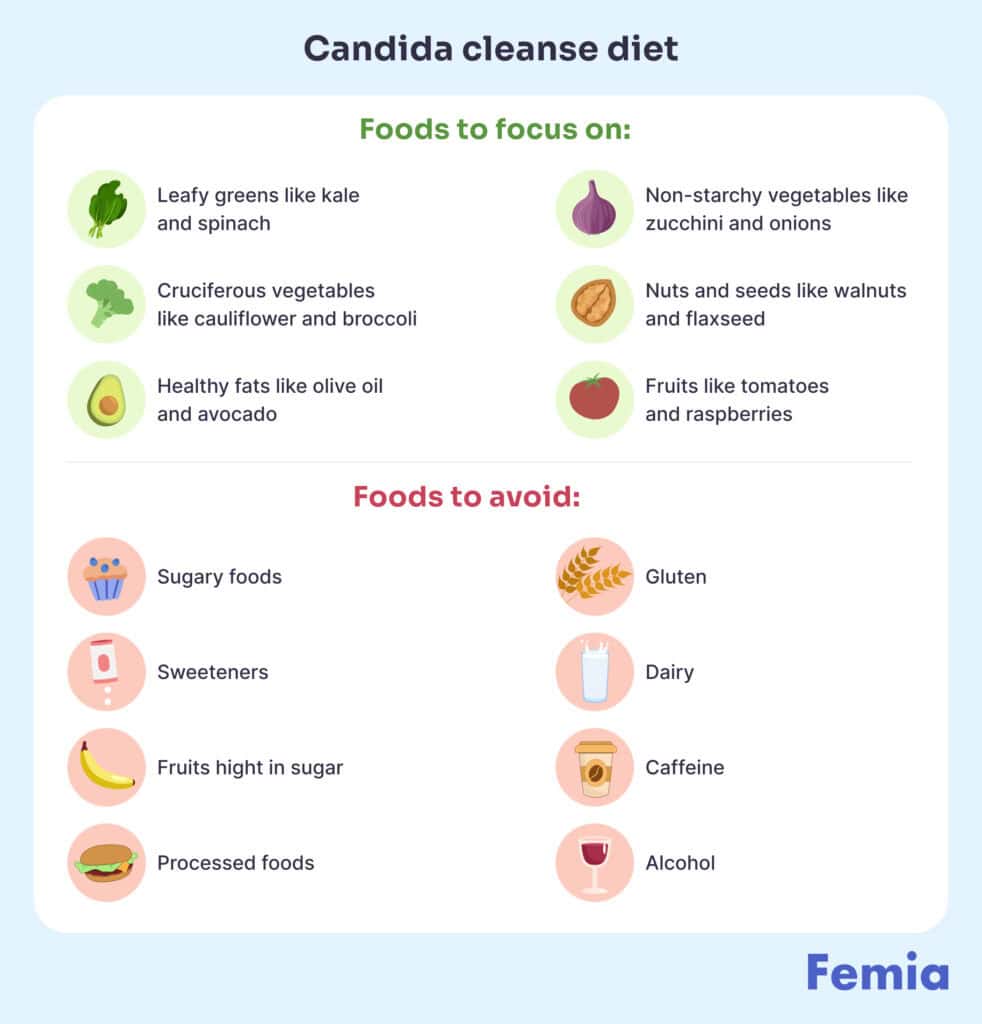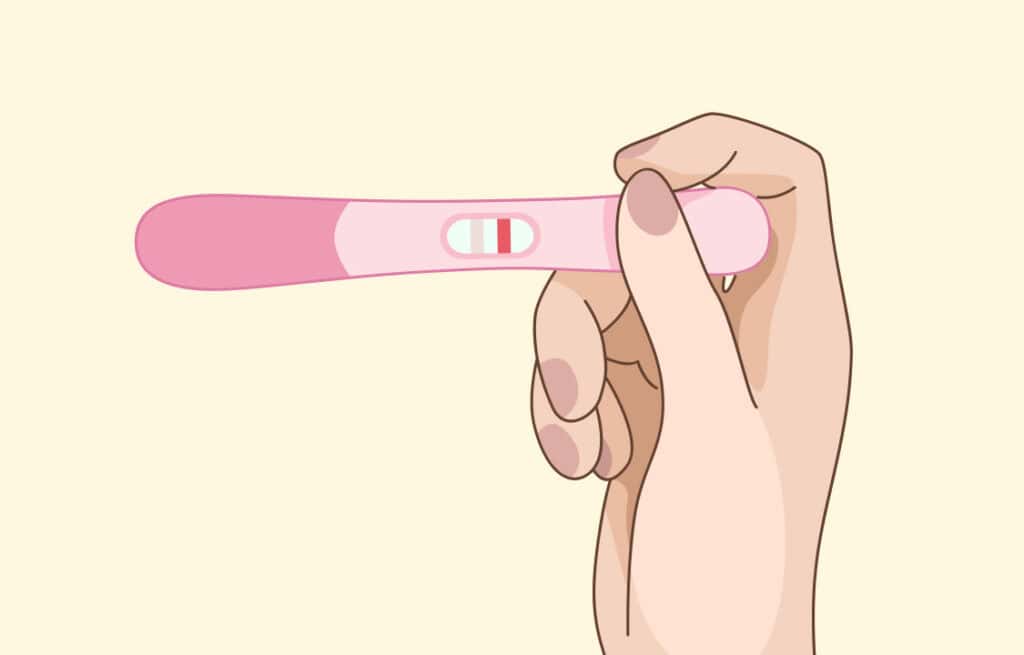Femia > Health Library > Your cycle > Health > Candida cleanse diet: Food list, meal plan, and recipes for a successful detox
Candida cleanse diet: Food list, meal plan, and recipes for a successful detox

- Updated Mar 1, 2025
- Published
CRAFTED BY HUMAN
Crafted by human At Femia, we provide accurate and up-to-date information at every stage of your journey, from trying to conceive, pregnancy and postnatal support. All content is created by a real person based on in-depth research and own professional experience. Femia ensures that you will receive expert advice, strict accuracy and a personalized approach from our authors/medical experts. Learn more about our editorial policy.
FACT CHECKED
Fact checked At Femia Health, we maintain the highest standards of editorial excellence in delivering content focused on helping you conceive, guiding you through pregnancy, and supporting you postpartum. Explore our content review principles to learn how we ensure the accuracy and quality of our health and lifestyle tips for every stage of your journey.

Created with Hector Chapa, MD, FACOG, Clinical associate professor, Obstetrics and Gynecology Texas A&M University, College of Medicine in Bryan-College Station, USA
Candida is a fungus found in the body. While it’s generally harmless, too much can lead to infection. The Candida cleanse diet aims to limit food and drink that might increase levels of Candida in the body. Followers of the Candida diet cleanse generally avoid processed foods, sugar, gluten, caffeine, and alcohol. While there isn’t any research backing up the Candida diet cleanse, fans are quick to defend it.
There are many different types of candida, and they exist happily in areas of your body such as your digestive system, vagina, mouth, and toenails. Sometimes, Candida can overgrow in the body and leave you battling symptoms of a fungal infection. If you’ve ever had thrush, you’ll know a yeast infection is no laughing matter. Oral thrush and vaginal thrush are two examples of infections caused by yeast overgrowth.
Fans claim that the Candida yeast cleanse diet can help alleviate symptoms like bloating, fatigue, and brain fog. However, critics say any health changes are likely due to eating better and have nothing to do with candida levels in the body. There is nothing in the way of peer-reviewed science to back up fans’ claims about the Candida cleanse diet, but there are likely general health benefits to be enjoyed from this new way of eating.

What is the candida cleanse diet?
The Candida diet cleanse aims to tackle Candida overgrowth in the body. Candida is a common fungus found in the body, but it can cause problems when it overgrows. A 2015 study published in Current Gastroengonology Reports found that symptoms of Candida overgrowth in the digestive system include bloating, nausea, diarrhea, and gas.
Does the candida cleanse diet works?
Though plenty of people are talking about this diet’s benefits, there isn’t any science detailing the success of this popular diet. The Candida diet focuses on low-sugar and anti-inflammatory foods to ensure optimal gut health.
Followers avoid sugar and gluten and instead focus on eating whole foods. The idea is to avoid foods that contain yeast and encourage yeast to grow. However, scientists are yet to understand why Candida overgrowth occurs and how to stop it, so this diet isn’t based on solid scientific facts.
At its core, the Candida diet restricts processed food and encourages lean protein, healthy fats, and fresh veggies, like many other diets. If you currently eat many processed foods, you’ll likely feel better on the Candida diet. However, that might not have anything to do with the candida levels in your body and will likely be because you’ve switched to a healthier way of eating.
👉Find out more: Egg white discharge: What it means for your cycle and fertility
Candida yeast cleanse diet: How long should you follow it?
You should follow the candida diet long enough to see the rewards of your hard work, generally at least four weeks. Even a shorter cleanse could improve your symptoms, but a longer-lasting change is more likely to get results.
It’s worth noting that the positive symptoms associated with this diet will likely stop when you go back to your previous eating habits. Long-term change is crucial for a healthier body. Short-term changes and yo-yo dieting can do more harm than good.
The Candida yeast cleanse diet isn’t recommended for pregnant and breastfeeding women. You should also skip this one if you have a history of eating disorders and disordered eating. Remember to get the go-ahead from your doctor before starting any cleanse or restricted diet.
Candida cleanse diet food list: What to eat and avoid

When starting a new diet, you must know what you can and can’t eat. As this diet involves cutting out sugar and gluten, you may need to find new food sources to fill your tummy.
For the Candida diet cleanse, you want a diet rich in:
- Lean proteins like fish and chicken
- Leafy greens like kale and spinach
- Cruciferous vegetables like cauliflower and broccoli
- Healthy fats like olive oil and avocado
- Non-starchy vegetables like zucchini and onions
- Nuts and seeds like walnuts and flaxseed
- Fruits like tomatoes and raspberries
You should avoid:
- Sugary foods
- Sweeteners
- Fruits high in sugar
- Processed foods
- Gluten
- Dairy
- Caffeine
- Alcohol
There are some foods you should avoid for the first few weeks of your diet but can then reintroduce. These include fermented foods, such as kimchi and sauerkraut—avoid them for the first month, then reintroduce them to aid healthy gut bacteria.
While there isn’t any specific research on the Candida diet, its core goal is to promote gut health, and there are some foods and spices known to help with this. A 2023 research review published in Microorganisms examined traditional medicines to identify anti-fungal food sources. The researchers identified several foods as being anti-fungal, including garlic, thyme, olive oil, ginger, cinnamon, and fermented vegetables. Including these foods may encourage healthy gut bacteria.
On the contrary, there is also some scientific evidence that contradicts what Candida-diet followers promote. A 2017 study published in Memorias do Instituto Oswaldo Cruz found that high fructose levels may restrict the growth of Candida, which is at odds with the Candida cleanse diet, which restricts high-fructose fruits.
Candida cleanse diet meal plan: Getting started
It can be tricky to know what to eat when you switch up your diet, so we’ve put together some inspiration for you.
Candida diet breakfast ideas
Breakfast cereals are often high in sugar, and other breakfast options include gluten. Here are some candida breakfast ideas for you to try:
- Chia seed puddling
- Scrambled eggs
- Coconut yogurt with fresh berries
- Homemade granola
- Gluten-free pancakes topped with berries
- Buckwheat breakfast muffins
- Oat bran porridge
- Smashed avocado on gluten-free bread
- Veggie omelet
- Yogurt parfait
Candida cleanse diet recipes for lunch, dinner, and snacks
There are many easy switches you can make in your typical meals to help your new diet be successful. For example, switch out rice for cauliflower rice, spaghetti for zucchini noodles, and homemade gluten-free tortilla wraps in place of bread. The key is to replace gluten and sugar with healthier alternatives.
Avoid or limit high-sugar vegetables such as sweet potato, beets, onions, green peas, and sweet corn. Eat plenty of low-sugar vegetables such as celery, kale, spinach, broccoli, and cucumber.
Here are a few recipes from the creators of the Candida diet for you to try:
- Southwestern souffle
- Buffalo cauliflower florets
- Zucchini and pesto bread
- Lemon coconut cookies
- Avocado mousse
👉Find out more: Cycle syncing: Optimize your lifestyle with your menstrual cycle phases
7 day Candida diet cleanse meal plan
To help you start your diet in style, we’ve compiled a tasty seven-day meal plan for you to follow:
Day 1:
- Breakfast: Spinach omelet
- Lunch: Chicken and avocado salad
- Dinner: Walnut bolognese with zucchini noodles
- Snacks: Hummus and vegetable crudites
Day 2
- Breakfast: Chia seed pudding with fresh berries
- Lunch: Cashew and vegetable stir fry with soba noodles
- Dinner: Lentil dahl with cauliflower rice
- Snacks: Gluten and sugar-free strawberry muffins
Day 3:
- Breakfast: Bircher museli
- Lunch: Tuna quinoa salad
- Dinner: Green Thai curry with chicken and cauliflower rice
- Snacks: Vegetable frittatas
Day 4:
- Breakfast: Gluten-free waffles with fresh fruit
- Lunch: Coconut and lime salmon with cauliflower rice salad
- Dinner: Buddha bowl with bean chili
- Snacks: Quinoa and buckwheat crackers with hummus
Day 5
- Breakfast: Buckwheat porridge
- Lunch: Curried cauliflower soup
- Dinner: Quinoa meatloaf and steamed vegetables
- Snacks: Fruit slices and peanut butter
Day 6
- Breakfast: Avocado pancakes
- Lunch: Grilled vegetable and buckwheat salad
- Dinner: Satay chicken bowl with stir-fried vegetables
- Snacks: Peanut butter energy bar
Day 7
- Breakfast: Scrambled eggs and vegetable hash
- Lunch: Quinoa falafel salad
- Dinner: Tandoori chicken and dahl
- Snacks: Celeriac soup

The bottom line
There isn’t any science backing up the Candida diet cleanse, but fans are quick to defend it. However, many of the benefits they report are likely to do with cutting out processed foods and eating more nutrient-rich options, improving overall health. Cutting out sugar, gluten, alcohol, and caffeine means you’re likely to cut out most processed foods and eat a diet rich in whole foods. This alone likely leaves people feeling better and has nothing to do with the fungus inside their bodies.
Reducing your processed food intake may boost your energy, reduce bloating, and leave you feeling better. Eating a diet rich in lean protein, fresh veggies, and healthy fats could boost your fiber intake, provide plenty of nutrients, and help you feel your best.
Following a meal plan can help you stick to a new diet, so it’s essential to plan what you eat in advance. And, don’t forget: you should consult with your healthcare provider before starting a radical new eating plan. While this diet might not work miracles on your Candida levels, it still may make you feel healthier and eliminate some unpleasant symptoms associated with eating a high-sugar junk food diet.
References
- Erdogan, Askin, and Satish S. C. Rao. “Small Intestinal Fungal Overgrowth.” Current Gastroenterology Reports, vol. 17, no. 4, 2015, p. 16, doi:10.1007/s11894-015-0436-2. PubMed, https://pubmed.ncbi.nlm.nih.gov/25786900/.
- Jawhara, Samir. “Healthy Diet and Lifestyle Improve the Gut Microbiota and Help Combat Fungal Infection.” Microorganisms, vol. 11, no. 6, 2023, p. 1556, doi:10.3390/microorganisms11061556. PubMed Central, https://www.ncbi.nlm.nih.gov/pmc/articles/PMC10302699/.
- Man, Adrian, et al. “New Perspectives on the Nutritional Factors Influencing Growth Rate of Candida Albicans in Diabetics. An In Vitro Study.” Memorias Do Instituto Oswaldo Cruz, vol. 112, no. 9, 2017, pp. 587-592, doi:10.1590/0074-02760170098. PubMed Central, https://www.ncbi.nlm.nih.gov/pmc/articles/PMC5572443/.
- Nehlig, Astrid. “Effects of Coffee on the Gastro-Intestinal Tract: A Narrative Review and Literature Update.” Nutrients, vol. 14, no. 2, 2022, p. 399, doi:10.3390/nu14020399. PubMed Central, https://www.ncbi.nlm.nih.gov/pmc/articles/PMC8778943/.
- Weig, M., et al. “Limited Effect of Refined Carbohydrate Dietary Supplementation on Colonization of the Gastrointestinal Tract of Healthy Subjects by Candida Albicans.” The American Journal of Clinical Nutrition, vol. 69, no. 6, 1999, pp. 1170-1173, doi:10.1093/ajcn/69.6.1170. PubMed, https://pubmed.ncbi.nlm.nih.gov/10357735/.
- Yapar, Nur. “Epidemiology and Risk Factors for Invasive Candidiasis.” Therapeutics and Clinical Risk Management, vol. 10, 2014, pp. 95-105, doi:10.2147/TCRM.S40160. PubMed Central, https://www.ncbi.nlm.nih.gov/pmc/articles/PMC3928396/.

Can sex make your period come early? For those of you wondering how to make your period come faster, we have compiled a list of natural and safe methods.

Learn how soon after sex should you take a pregnancy test. Discover the best timing for a pregnancy test after sex. Expert tips and advice. Get all the answers on Femia.

Is period sex bad for you? No, not at all. Does having sex on your period help with cramps? Yes, it might even come with some benefits like pain relief and mood boost.
